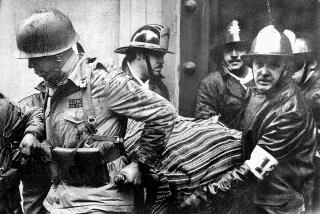Hoover Archivists Find Large Trotsky Collection
- Share via
SAN FRANCISCO — Thousands of personal papers belonging to the seminal Soviet revolutionary Leon Trotsky, including an attack against bitter rival Josef Stalin penned in invisible ink in the margins of a book, have been found by scholars at the Hoover Institution in Palo Alto.
The remarkable find, consisting of 35 folders of photographs and more than 70 boxes of letters, speeches, notebooks, reports and other papers, were sold to the Stanford University-affiliated institute in 1963 by a Russian emigre, Boris I. Nicolaevsky.
For the record:
12:00 a.m. June 12, 1987 For the Record
Los Angeles Times Friday June 12, 1987 Home Edition Part 1 Page 2 Column 1 Metro Desk 1 inches; 35 words Type of Material: Correction
An article in Thursday’s Times about the recent discovery of documents belonging to Russian revolutionary Leon Trotsky misidentified the publisher of The American Historical Review. The magazine is published by the American Historical Assn.
The Trotsky papers were a small part of Nicolaevsky’s much larger collection of materials documenting socialist movements in Europe in the late 19th and early 20th centuries. Hoover archivists were unaware of the Trotsky papers until after the 1982 death of Anna Bourguina, Nicolaevsky’s widow and curator of the collection after her husband’s death in 1966.
Hoover archivist Dale Reed acknowledged that Harvard University still has the “largest and most important” collection of original Trotsky materials. But he described the documents as “an exceptionally important new historical source” and “a very important supplement” to the Harvard collection.
Although it may take years to fully study the new material, historians outside the Hoover Institution said the value of the collection appears to be that it illuminates what already is known or believed about Trotsky, but does not offer a radically new vision of the man or his relationship with Stalin.
“Any papers that are original papers of Leon Trotsky are interesting and important,” said Reginald E. Zelnik, a professor and vice chairman of the University of California, Berkeley, history department. “But nobody has yet said anything that tells me there’s something explosive in it.
“There may be some really important new insights there,” he added, noting that the entire collection was only recently fully catalogued. “But if there is, they probably don’t even know about it yet.”
In addition to covering Trotsky’s political thoughts, the Hoover collection also gives some personal insight into Trotsky, the son of an affluent Ukrainian farmer who organized the Red Army and at one point was seen by many Soviets as heir apparent to Bolshevik leader V. I. Lenin.
After Lenin’s death in 1922, however, Trotsky was politically outmaneuvered by Stalin and, in 1929, was exiled to Turkey. He eventually settled in Mexico, where he vociferously criticized the murderous Stalin regime until a Stalinist agent assassinated him in 1940. He was 60 years old.
As described in the latest issue of the institute’s magazine, The American Historical Review, the material at Hoover is primarily from the early part of Trotsky’s exile--the weakest period in the Harvard collection--and could help to illuminate the power struggle that brought Stalin to power.
“Scholars will be especially interested in the . . . holdings of manuscripts and works by Trotsky for which no other manuscripts are known to exist,” Reed wrote with his co-author, Michael Jakobson. “The most significant work is undoubtedly ‘History of the Russian Revolution’ (1931). The only known drafts of this historical classic occupy more than 10 linear feet of shelf space.”
Included are one complete chapter giving an account of a 1917 counter-revolution that was left out of published versions of the book, as well as many unpublished fragments detailing the relationship between the embryonic Soviet revolutionary government and various segments of contemporary society, including the army, bureaucracy, church and trade unions.
The Hoover collection also includes apparently unique manuscripts for books such as “What Next?” and “The Only Road,” both of which analyze the birth and rise of fascism in Germany in the early 1930s. Reed and Jakobson also assert that Hoover now holds the only known manuscript for Trotsky’s 1934 book, “War and the Fourth International.”
Reed and Jakobson also describe a series of 46 papers gathered by Trotsky’s son and political confidant, Leon Sedov, from sympathetic Soviet diplomats and foreign visitors to the Soviet Union. The reports, from 1929 to 1937, describe the social, political and economic conditions within the country during one of its most difficult periods.
The most unusual document may be the invisible-ink invective jotted in the margin of a published diary of the poet Alexander Blok. A letter expressing the same views has already been published as Trotsky’s angry response to a visit by secret police shortly before his exile. Reed and Jakobson speculate that he wrote a version of the letter in the book in invisible ink--which has since become visible--as a way to smuggle the letter out of the country for publication abroad.
Overall, the Hoover collection includes material from the period from 1931 to 1938. The bulk of the documents, however, are dated from 1931 to 1933, when Trotsky was in exile in Turkey and then moved to France.
“I don’t think that one could say that this collection calls for a radical revision of our historical view of Trotsky,” Reed said, “but it does fill in a lot of gaps.”
More to Read
Sign up for Essential California
The most important California stories and recommendations in your inbox every morning.
You may occasionally receive promotional content from the Los Angeles Times.













